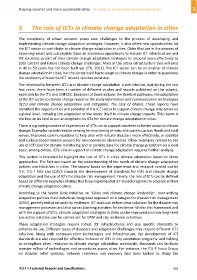Page 569 - Shaping smarter and more sustainable cities - Striving for sustainable development goals
P. 569
3 The role of ICTs in climate change adaptation in cities
The complexity of urban contexts poses new challenges to the process of developing and
implementing climate change adaptation strategies. However, it also offers new opportunities for
the ICT sector to contribute to climate change adaptation in cities. Cities that are in the process of
becoming smart and sustainable, have an enormous opportunity to include ICT infrastructure and
ICT solutions as part of their climate change adaptation strategies to respond more effectively to
both current and future climate change challenges. Most of the urban infrastructure that will exist
in 40 to 50 years has not been built yet (ITU, 2012). The ICT sector can be an enabler of climate
change adaptation in cities, but the sector itself has to adapt to climate change in order to guarantee
the continuity of essential ICT‐related services provision.
The relationship between ICTs and climate change adaptation is not intuitive, but during the last
few years, there have been a number of different studies and reports published on this subject,
especially by the ITU and UNFCCC. Examples of these include: the Resilient pathways: the adaptation
of the ICT sector to climate change report or the study Information and communication technologies
(ICTs) and climate change adaptation and mitigation: The case of Ghana. These reports have
identified the opportunities and potential of the ICT sector to support climate change adaptation on
a global level, including the adaptation of the sector itself to climate change impacts. This report is
the first on its kind to put an emphasis on ICTs for climate change adaptation in cities.
There is a growing number of experiences of ICTs use to support countries to better adapt to climate
change. Examples include remote sensing for monitoring of natural disasters such as floods and tidal
waves, improved communications to help deal with natural disasters more effectively, or satellite
and surface‐based remote sensors for environmental observation. Other examples related to the
use of ICT tools for climate monitoring and to provide data for climate change prediction on a local
basis, among others. ICTs' role in support of climate change adaptation requires further analysis.
This section is intended to highlight the role of ICTs in cities climate adaptation based on three
approaches. The first one based on the understanding of the needs of climate change adaptation
policies and initiatives in cities. The second based on the experience and research carried out by
ITU, ITU‐T SG5 and Q15/5 towards the development of standards for ICTs and climate change
adaptation and the use of ICTs for disaster risk management. Finally, the role of ICTs can be defined
based on different examples of cities that have implemented ICT‐based programs to advance in their
climate change adaptation plans.
According to the World Bank initiative on "Cities and climate change leadership", over‐arching
adaptation policies must include an integrated approach on strategies for disaster risk management
(DRM), poverty reduction and city resilience. ICT tools can deliver clear solutions for the disaster risk
management processes and also across planning activities for resilience. Within this framework and
with the support of ICTs, climate adaptation strategies in cities can be improved and new long‐term
pro‐active solutions can be carried out for DRM and city resilience initiatives.
These adaptation strategies require robust ICT infrastructures and also specific standards to
enhance its use. Different types of disasters and adaptation challenges may require different ICTs
solutions. Along with communication technologies and infrastructure, the development of ICT
standards are also required for effective inclusion of ICTs in city adaptation programs; and helping
to strengthen cities' response to climate change adaptation worldwide. Standards can facilitate
massive rollout of technologies and procedures across cities. For instance, the ITU‐T Focus Group
on disaster relief systems, network resilience and recovery had been tasked to study the
ITU‐T's Technical Reports and Specifications 559

